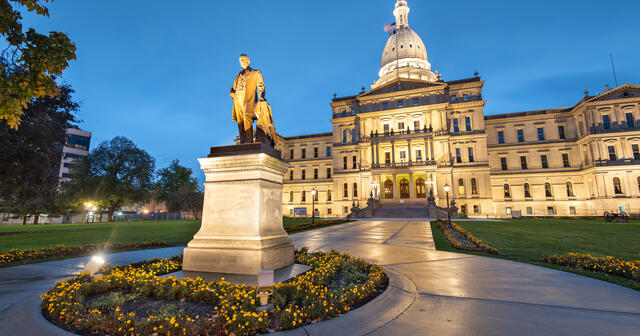

Legislators are likely to pass a state budget that spends less than Sustainable Michigan Budget limits. Yet they will do so without having to practice much restraint.
According to the state’s forecasters, revenue for the upcoming year is expected to decline slightly from the current fiscal year.
The House and Senate already have passed their budgets, and the increase in state spending — which doesn’t include money from federal or state sources — falls within the level of sustainability derived by combining the 7.9% inflation rate and population growth.
Inflation has been high. The limit figures are based on inflation experienced over the last two fiscal years. That includes some of the highest inflation numbers in over 40 years. It’s come down a bit since then, with the most recent year-over-year inflation index at 5.0%.
While the budget this year is limited by low growth, this only comes after substantial increases over the past few years. State spending has increased 70% since the 2012-13 fiscal year, while inflation increased just 19% and the population remained around 10 million people. This kind of spending growth is unsustainable.
There has not been a lot of moderation in previous years. Nor are lawmakers practicing much restraint with their current budget proposals.
There’s a half billion — around $125 per household — for a local partnership initiative in the Senate budget. Legislators added 21 vaguely economic goals for the program, so it could go for anything administrators want. If lawmakers want to set up this grant, they ought to have the idea negotiated and put into statute first. The state government should have a clear idea about what it wants to accomplish before allocating an amount that is larger than what it gives to community colleges.
Another half-billion is money for the governor to hand out to whatever businesses she chooses. Ostensibly, this fund is intended to add jobs. But showering taxpayer money on select businesses is ineffective for creating jobs, unfair to competing businesses, and expensive to the state budget. House members did not include it in their budget, so maybe enough has been enough.
There are tens of millions for convention centers and efforts to attract events to the state. If drawing people in for conventions is a good thing for a city, its own taxpayers should foot the bill. They’re already authorized to improve their convention centers if it’s a priority for them.
Michigan has an endowment fund to improve state and local parks. Voters recently approved a constitutional amendment to ensure that it keeps growing. Legislators are going to use extra taxpayer money to put a couple of projects to the front of the line.
Or $40 million for electric vehicle infrastructure. If there’s going to be sustainable infrastructure for electric vehicles, it will be because there is a demand for it from users. There aren’t gas stations dotting the country because Washington or Lansing spent taxpayer cash building them.
Hundreds of millions in projects going to particular legislators’ districts popped in at the last minute over the past few years. People will just have to wait to see if that happens again this year.
Republican legislators left $9 billion in surplus funds last year. What have the new Democratic majorities done with it? Corporate welfare was their largest priority. They’ve authorized $2.9 billion to companies of the governor’s choosing. And more is being discussed in the Legislature.
Budgets aren’t the only place to establish priorities. Elected officials changed some tax policies, too, giving special exemptions to pensioners but not to other retirees. They increased spending on a social assistance program. They stopped fighting the scheduled income tax reduction and let that happen, though they may try to budget based on the bad assumption that it is temporary.
The road-funding governor has gotten us further from fixing the roads. The goal should be to improve roads faster than they fall apart, which sets the state up for long-term improvements in road quality. There was enough money to keep roads from deteriorating further when the governor began. Now road quality is expected to decline.
There are benefits to not spending every dollar available. It allows legislators to be flexible for the future. And if nothing else, lawmakers can pay down state debts if there are no other uses for state cash. The state accidentally made school employees the state’s largest creditors, and that’s bad for teachers and taxpayers alike.
While the budget is likely to come in below the rate of growth of the state’s population plus inflation, there is not a lot of restraint being practiced in the budget this year. There should be more. These spending plans could use a skeptical look, and the state would be better off to hesitate before spending so much.
Permission to reprint this blog post in whole or in part is hereby granted, provided that the author (or authors) and the Mackinac Center for Public Policy are properly cited.
Get insightful commentary and the most reliable research on Michigan issues sent straight to your inbox.


The Mackinac Center for Public Policy is a nonprofit research and educational institute that advances the principles of free markets and limited government. Through our research and education programs, we challenge government overreach and advocate for a free-market approach to public policy that frees people to realize their potential and dreams.
Please consider contributing to our work to advance a freer and more prosperous state.

Donate | About | Blog | Pressroom | Publications | Careers | Site Map | Email Signup | Contact